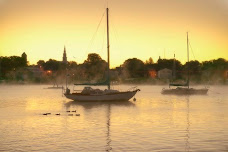
 I was a sophomore at Providence's Classical High School in 1967, the year that the Rhode Island Mall (then called the Midland Mall) opened in Warwick. That year is generally thought of as marking the end of retail in downtown Providence — at least, until the present "renaissance."
I was a sophomore at Providence's Classical High School in 1967, the year that the Rhode Island Mall (then called the Midland Mall) opened in Warwick. That year is generally thought of as marking the end of retail in downtown Providence — at least, until the present "renaissance."But it isn't really fair to say that the opening of the Warwick malls killed downtown, because it had already been failing. An effort to restore vitality to Westminster Street by turning it into a pedestrian walkway closed to cars wasn't working, even though as late as the mid-'60s, the street was still lined with stores that were far busier than those that are there today, 40 years later.
In the old postcard view on the left, you can see the planters that occupied the middle of the Westminster pedestrian mall, along with shoppers heading for stores like Woolworth and Thom McCan shoes on the left side and Kay Jewelers on the right. At that time, the two big downtown department stores were still operating — Shepard's and the Outlet — along with dozens of smaller stores like Peerless, Gladding's, Lerner and Casual Corner.
All are gone now, and the present view (right), taken from the corner of Westminster and Union Street (next to Tazza cafe), shows the planters gone, the street reopened to cars — and an absence of shoppers on a weekday afternoon. This might be because the stores that have opened in the past few years on Westminster are determinedly upscale: A wine boutique called Eno, a modern furniture store called Design Within Reach (whose?), and women's fashion stores such as Elsa Arms are typical. Other than a few stores like Oop and Bowl & Board that cater to students decorating their dorms, there's little for sale on Westminster to draw the everyday shopper. The expectation is that the hundreds of condos for sale downtown will soon fill with well-to-do people who will need to buy fine wine and Eames chairs but who won't need to run out for groceries or a pair of stockings or a tube of toothpaste.
It generally works better, though, when stores go where the people are. In 1967, the malls were built in the suburbs because that's where the people had moved. Speaking about the Warwick malls, which he co-managed, for a 1999 Providence Journal article, developer Aram Garabedian said, "The shopping center (in Warwick) followed the people; the people didn't follow the shopping center."
Forty years later, Providence is still hoping they'll be back soon.







